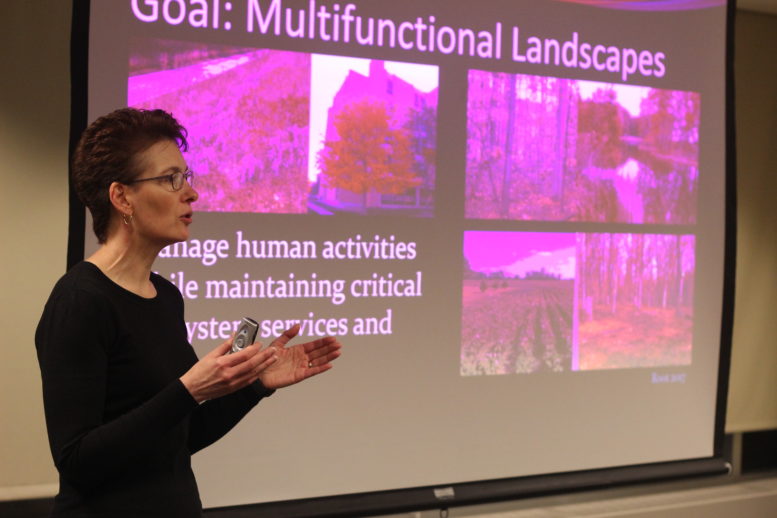By DAVID DUPONT
BG Independent News
Fostering biodiversity doesn’t require only setting aside large tracks of natural lands.
Fostering wild areas amidst farmland and suburbs could very well help maintain the habitat native species need. That’s especially true in an area like the Great Black Swamp where agriculture and suburbs encroach on the habitat of turtles, butterflies, bats, and the rest of the natural community.
Conservation biologist Karen Root discussed her studies the natural habitat of the Oak Openings region.
The professor at Bowling Green State University was the opening act in this week’s sustainability activities on campus. The maps she projected showed the threat to the area’s oak savannah and prairies. While forest has increased in some parts, the white areas representing suburbs moved noticeably south in the last decade. To the south of Oak Openings were large swatches of agricultural land, which with their expanse of single crop planting are in many ways the worst habitat for wildlife.
Root has been studying the impact that those changes in land use have had. Those studies, she made clear, require getting your boots muddy. Collecting the data takes a host of students and community volunteers.
For students that mean keeping track of road kill on certain stretches of road. They found 292 dead animals, 255 of them mammals. “We think that’s unusually high,” she said.
Mammals, Root said, are the prime victims of vehicles, and the area where the Oak Opening Preserve and Maumee State meet is the worst spot.
Looking at roads, and the state of vegetation along the edges, though, offers clues on how the death toll could be reduced. Areas with more cover along the side of the road tend to protect animals better.
Having areas where animals can travel from one natural area to another is key, since often one area may not have everything a species requires.
Root tracked the movements of other species, such as box turtles to see how far they roam, which can be surprisingly far. This is done by applying fluorescent chalk to the bottom of their shells, so they leave a trail.
Root showed a photo of one turtle that had the distinctive marks having been burned. Many times, she said, those using controlled burns to get rid of invasive plant species don’t consider the creatures who may be affected.
The construction of wind turbines is another action considered good for the environment that can have unintended consequences.
Root said she studied the effect of the local turbines on bats and has found some fatality, especially among red bats. The bats are not killed by colliding with the blades, but changes in air pressure near the blades.
The fatality rate isn’t great and occurs only when the bats are migrating, she said. The turbines could be turned off during that brief period, she said.
Another faculty member, Andrew Gregory, a spatial ecologist, noted that on large wind farms, only a few turbines on the periphery need to be turned off.
Bats, Root said, face more severe problems.
Volunteer surveyors use Anabat detectors to find the mammals. These pick up their sounds which are undetectable to human ears. The sounds are different for different species, and also can tell what the bat is doing.
Root said there are eight species in the area, and all eight were detected throughout the Oak Openings Metro Park. Bats benefit from forest cover with “modest amounts of cover on the ground.” They like vegetation at different levels. She was surprised at the number of bats located near roads.
They also like higher temperatures which has caused some speculation about the impact of global warming.
However, bats, especially certain rare species, are in decline. The fungus known as White Nose Syndrome is decimating some to the point of near extinction. The disease, Root said, is probably spread in the caves down south where bats roost in winter.
The common brown bat species, those that like to roost in barns and house attics, are the most common and are doing best.
Root invoked Biologist E.O. Wilson’s “half-earth proposal” posited in his 2016 book. Wilson says that to sustain biodiversity humans should set aside half the earth for nature.
Such a notion may seem far-fetched but Root said “I think we can do that with multifunctional landscapes.” That means wild edges along the agricultural lands, park area within suburban areas, managing roadsides, and connections between complementary areas.

